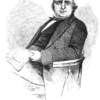
Rebecca Nesvet, “Miss Whitehead, ‘The Bank Nun’”
An urban legend maintains that early in the nineteenth century, one Miss Whitehead, colloquially known as “the Bank Nun,” frequently visited the Bank of England to accuse that institution of destroying her brother, a financial forger. This essay traces the evolution of this legend. I contend that in 1837, an obscure comic sketch reacted to that year’s major financial crisis by dredging up the Romantic-era case of financial forger Paul Whitehead and focusing on his surviving sister. Displacing her brother’s notoriety onto her, the sketch reinvents her as “the Bank Nun,” a grotesque magnet for lingering Romantic-era anxieties about the circulation of paper credit, financial forgery, and women. A succession of plagiarisms, retellings, and reappraisals of this ephemeral sketch and its portrait illustration made the Bank Nun a folk heroine of enduring resonance. Via this iconic figure, Romantic-era economic controversy haunts London today.

Janice Schroeder, “The Publishing History of Henry Mayhew’s London Labour and the London Poor”
Versions of Henry Mayhew’s massive social survey London Labour and the London Poor appeared in several publishing formats, including newspaper column, weekly serial, live stage show, and bound volume. This article traces the republication and remediation of London Labour alongside Mayhew’s repackaging of his interviews with London “street-folk” from 1849 onwards. I offer a succinct, accessible account of the complex publishing history of the text, from print newspaper column to digital edition.

Kathleen Frederickson, “British Writers on Population, Infrastructure, and the Great Indian Famine of 1876-8”
This article examines British writing about the 1876-8 famine in southern and western India. In British newspapers and journals, the turn to thinking about famine in terms of the total population obscured the extreme variations in food access that worsened with rising economic inequality. When the British press in the late-1870s turned to human causes of famine, they either argued that India’s population overburdened India’s land, or suggested that more rail construction would prevent enough deaths sufficiently to mitigate British responsibility for famine conditions. The turn to population-based arguments helped either to perpetuate the belief that famine was a quasi-natural part of India or to parse the sudden increase in the frequency and severity famines in India under British rule.

Lynn Shakinovsky, “The 1857 Financial Crisis and the Suspension of the 1844 Bank Act”
The 1857 financial crisis began in the United States and reached England in October of that year with the fall of the Liverpool Boro’ Bank. This essay examines representations of and responses to the crisis by some of the major figures and key sources of the period. While an increasingly widespread acknowledgement of the inevitability, at times even of the desirability, of crisis manifests itself in various representations and discussions of the financial crisis, the diverse ideological assumptions and expectations of various writers, politicians, and journalists proffer widely differing explanations and solutions. These range from Marx and Engels who saw in the crisis the opportunity for revolution, to entrenched capitalists who regarded it as a necessary occurrence for the promotion of further growth, to politicians and bankers who called for new interventions in the Banking system. Through an investigation of political, journalistic, and academic responses to the 1857 crisis and the suspension of the Bank Charter Act of 1844, this paper explores the political and economic significance of the crisis for mid-century global capitalism and the Banking system.

Alexander J. Dick, “On the Financial Crisis, 1825-26”
The crash of 1825-1826 was the first modern financial crisis. Unlike earlier speculative bubbles, the 1825 crisis was not caused only by exogenous circumstances like war or overzealous investment. The real cause of the 1825 crisis was the diversification of the finance economy into tiny investment units—a loan here, an insurance policy there—offered as seemingly responsible ways to maintain credit and generate capital. When the market finally did crash, no single group or class could be blamed for causing it. Economists came to realize that the market was always at the mercy of booms and busts and that no single individuals or professions within it could be said to be in charge of it. In other words, 1825 marks the moment at which capitalism grew from an ideological enterprise into a global condition. 1825 also marks a crucial transition in the publishing industry, the point at which the traditional market for vellum-bound epics and triple-decker novels was eclipsed by cheap reprints and serial publications. It thus signals the end of what we might call the Romantic ideal and the emergence of an existential malaise in English literature that persists in Victorian writing and beyond.

Angela Esterhammer, “1824: Improvisation, Speculation, and Identity-Construction”
Literature and cultural history of the year 1824 reflect the prominence of improvisation and speculation as ideologies and modes of action. Both these terms suggest hasty action that lacks a solid or profound basis, that responds to contingencies and constructs its own (pseudo-)reality. This article explores modalities of improvisation and speculation by focusing on the interrelated themes of ephemerality, appearance, and identity-construction in texts and performances of the year 1824, including influential works of poetry and fiction, the burgeoning periodical press, and new forms of theatrical entertainment.

Joshua Gooch, “On ‘Black Friday,’ 11 May 1866”
The panic of 11 May 1866, initiated by the collapse of Overend, Gurney, and Company, offers a useful vantage point to survey changes in British finance, economics, and politics, as well as the cultural perception of those changes. The panic exemplifies the expansion of London’s credit markets, the effects of the 1862 Companies Act, and the emergence of a clarified central bank policy. In addition, the panic crystallizes a shift toward statistical, impersonal, and biological descriptions in economic thought alongside the emergence of multi-perspectival character narration in texts like Robert Browning’s The Ring and the Book and Wilkie Collins’s The Moonstone.
